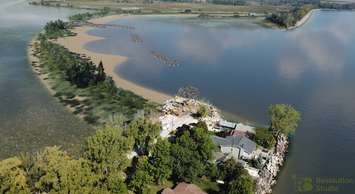Phase two of the stable barrier beach project at Hillman Marsh was recently presented to the Essex Region Conservation Authority (ERCA).
The barrier beach project is an ongoing effort to protect the marsh from large waves, extreme storms, and climate change stressors, as well as sustain the habitat for various species of flora and fauna.
"This restoration work is extremely important to ensure the long-term ecological health of the marsh and to improve water quality leaving these watersheds, and also to assist with protecting the homes in this east Leamington area," said Kevin Money, ERCA's Director of Conservation Services.
Last week, Seth Logan, a consultant with SJL Engineering, presented modelling based on the preferred restoration concept, which was chosen following an 18-month consultation process that included municipal, provincial, and federal governments, academia, NGOs, consulting and engineering firms, First Nations, and local representatives.
Logan showed work done at the National Research Council of Canada's Ocean, Coastal, and River Engineering Research Centre in Ottawa, including a one to 40 scale model constructed at the site to test the concept's resilience against various wave and water level scenarios. Historical storm data was also used to pinpoint events that contributed to the failure of the barrier beach and help guard against similar storms from causing issues in the future.

"This was an important step, and while costly, it allowed us to optimize the design and reduce the anticipated construction cost estimates by roughly $3 million," explained Logan. "It also provided added confidence that the design would perform well and meet our project objectives for the most severe conditions expected throughout its design life."
Phase one of the restoration work was undertaken in 2024. It included stabilizing a section of the eroding shoreline to improve its resilience to climate change, using both traditional engineering and nature-based solutions.
The next step of the project is the detailed design development and costing, with hopes that the final engineering will be completed and ready for tender in 2026.





![Apartment for rent sign, [Blacqbook]/[iStock / Getty Images Plus] via Getty Images"](https://media.mynewstoday.ca/i/r9ayQA98/355/205)
